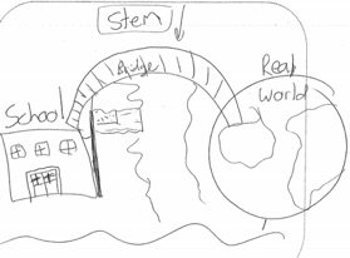What it Means to be STEM
If you are an educator, chances are you've heard of STEM. There's also STEAM. And STEAMM. And iSTEM. And...well, you get the idea. But oddly enough STEM isn't a new concept. It's just a new package. A quick search of Wikipedia and you will find that STEM used to be METS. Surprised? I was. No, not really.
So, in a nutshell, STEM and all its weird cousins are just another way of talking about curricular integration. A road-map of exquisite instruction where science meets technology and engineering and math. I think of it like teaching the way the world really works, as opposed to teaching subjects in silos, sterile and separate, each compartmentalized and disjointed from reality.
 STEM for me is having kids take a topic that matters and figuring out an answer that can't be googled. With the advancement in technology, the world has changed. Individuals of one town no longer compete against each other for jobs at the local factory. Instead, they are competing globally for career opportunities and jobs that their grandparents swear are something off of Star Trek.
STEM for me is having kids take a topic that matters and figuring out an answer that can't be googled. With the advancement in technology, the world has changed. Individuals of one town no longer compete against each other for jobs at the local factory. Instead, they are competing globally for career opportunities and jobs that their grandparents swear are something off of Star Trek.
There's more to STEM than just subject matter. 21st century skills is another buzz word that, in my world, is the peanut butter to my STEM jelly. My favorite 21st century skills are critical thinking, problem solving, communication, and collaboration. Forget memorizing the state capitals. Everyone can google that. And seriously, when have you ever needed to rattle off the state capitals? Anyway, instead of rote memorization of facts, STEM is a way of teaching students how to think. You know, that critical skill we've drained out of them by focusing on test scores (did I really just say that? Oh my, scandalous.) If you're curious to know more about 21st century skills, I highly recommend going to www.p21.org Great stuff over there. Like this blog post I found about the 10 best ways to make your projects more authentic.
Which leads me to the how of STEM education. Project and Problem based learning are major components of STEM education. There's some raging debate out there about the difference, but honestly if you are doing them correctly they're similar. I lean toward Problem based learning, where kids start with a problem they need to solve and work toward solutions. In doing that, they often build or create something in the process and Viola! Project. It's a misunderstanding that these things require messy glue and cardboard and duct tape all the time. PBL's can be computer based, or even paper based. Someone who writes a book or a song is creating something, right?
The design process is another critical component of STEM education. And again, there are many versions out there to use. The premise of all of them is the same: start with a problem, research that problem a little bit, brainstorm solutions to that problem, then create and test solutions until you find one that works or you run out of time. Then present what you discovered.

or my favorite one:

I happen to be quite fond of STEM, or STEAMM, rather. The extra M stands for, in our case, Medicine. At my middle school, STEAMM is Science, Technology, Engineering, Art, Math, and Medicine. It's my job to find ways to integrate medicine into the equation. I love the challenge. I especially love that this is a problem I can't google ;-)





Comments
Post a Comment